Retail-Fashion Industry Zara: Analysis and Recommendations
VerifiedAdded on 2023/06/14
|15
|3863
|341
AI Summary
This article provides an analysis of Zara's market position, PESTLE analysis, competitive analysis, and identification of relevant changes in the retail-fashion industry. Recommendations are also provided for Zara's future growth.
Contribute Materials
Your contribution can guide someone’s learning journey. Share your
documents today.
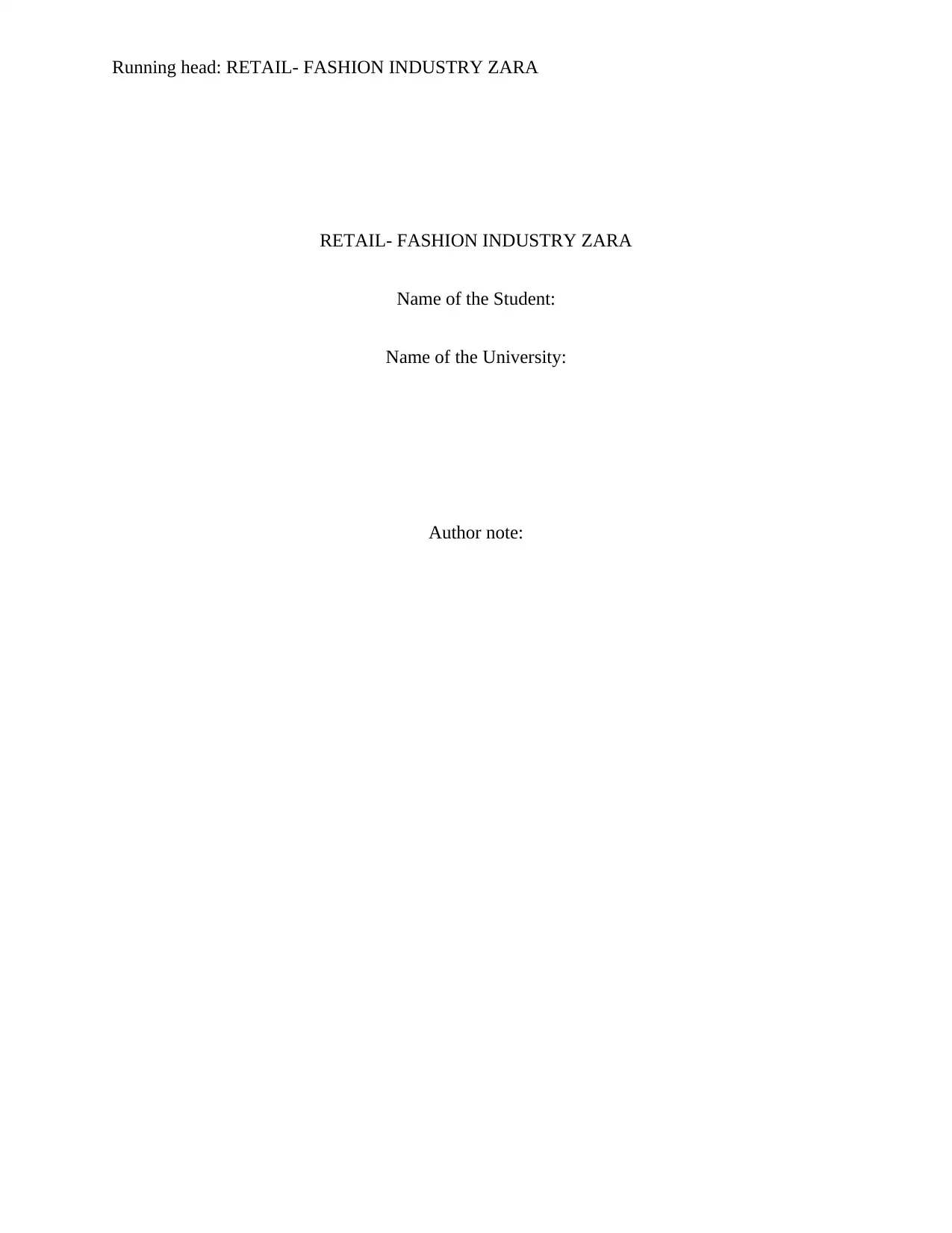
Running head: RETAIL- FASHION INDUSTRY ZARA
RETAIL- FASHION INDUSTRY ZARA
Name of the Student:
Name of the University:
Author note:
RETAIL- FASHION INDUSTRY ZARA
Name of the Student:
Name of the University:
Author note:
Secure Best Marks with AI Grader
Need help grading? Try our AI Grader for instant feedback on your assignments.
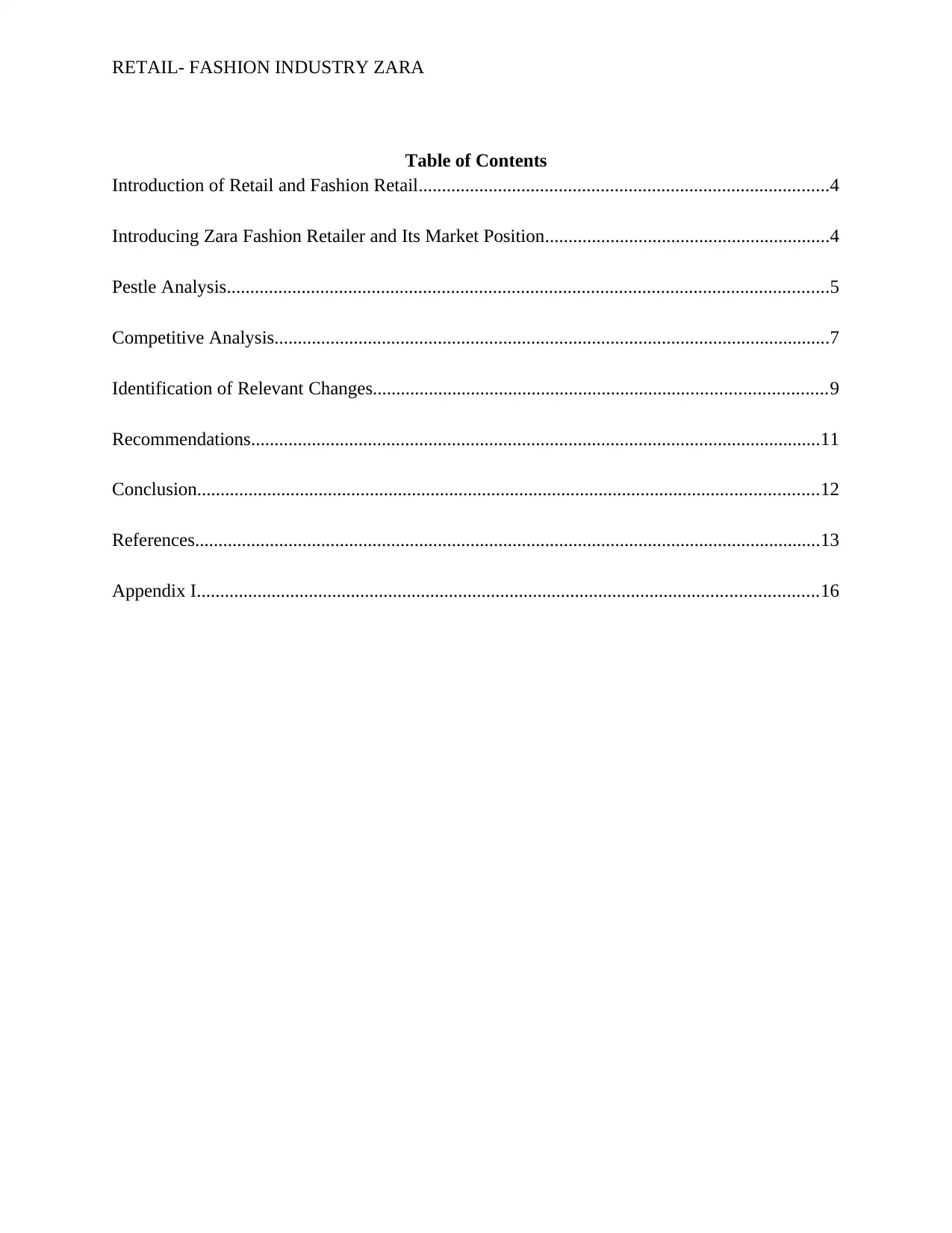
RETAIL- FASHION INDUSTRY ZARA
Table of Contents
Introduction of Retail and Fashion Retail........................................................................................4
Introducing Zara Fashion Retailer and Its Market Position.............................................................4
Pestle Analysis.................................................................................................................................5
Competitive Analysis.......................................................................................................................7
Identification of Relevant Changes.................................................................................................9
Recommendations..........................................................................................................................11
Conclusion.....................................................................................................................................12
References......................................................................................................................................13
Appendix I.....................................................................................................................................16
Table of Contents
Introduction of Retail and Fashion Retail........................................................................................4
Introducing Zara Fashion Retailer and Its Market Position.............................................................4
Pestle Analysis.................................................................................................................................5
Competitive Analysis.......................................................................................................................7
Identification of Relevant Changes.................................................................................................9
Recommendations..........................................................................................................................11
Conclusion.....................................................................................................................................12
References......................................................................................................................................13
Appendix I.....................................................................................................................................16
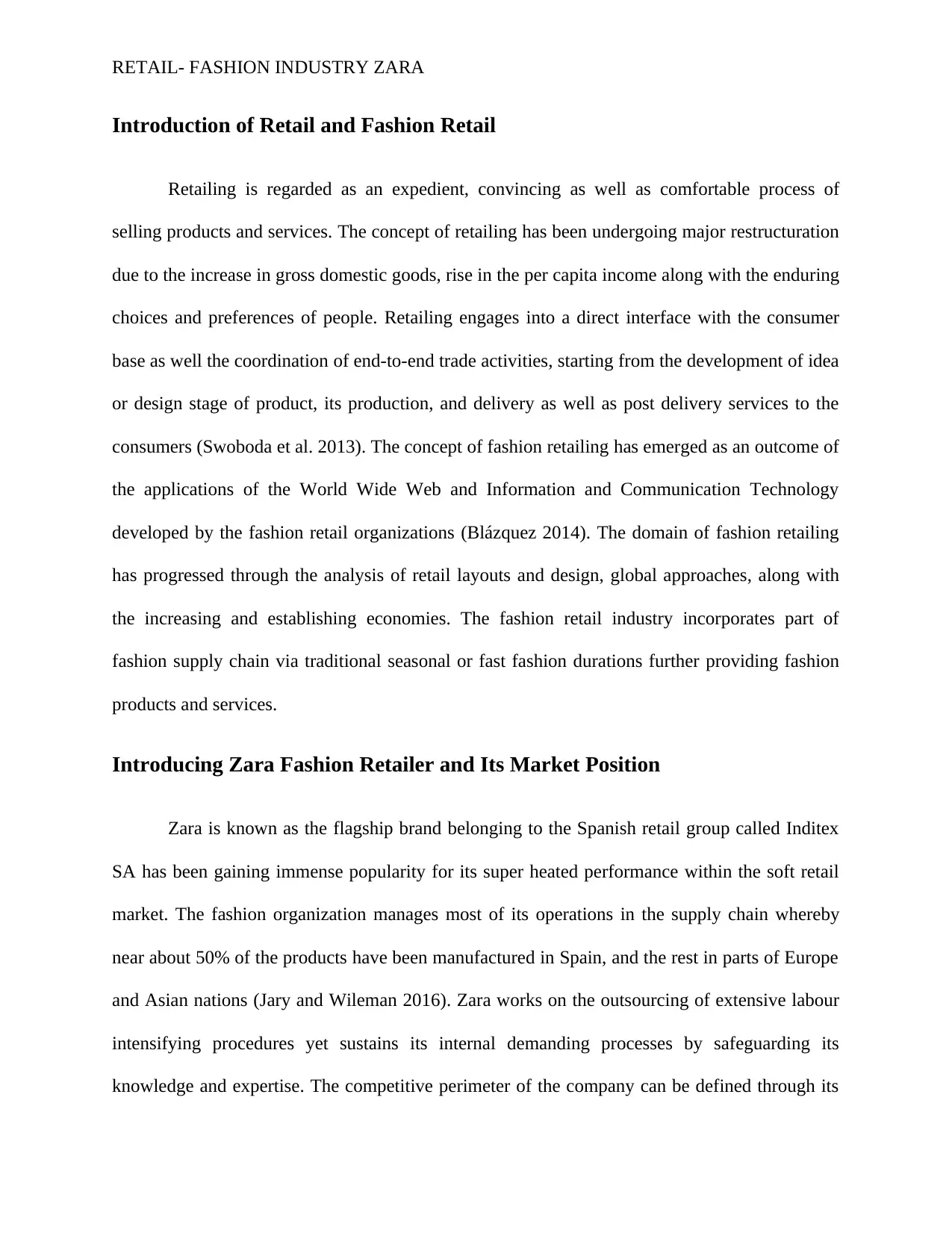
RETAIL- FASHION INDUSTRY ZARA
Introduction of Retail and Fashion Retail
Retailing is regarded as an expedient, convincing as well as comfortable process of
selling products and services. The concept of retailing has been undergoing major restructuration
due to the increase in gross domestic goods, rise in the per capita income along with the enduring
choices and preferences of people. Retailing engages into a direct interface with the consumer
base as well the coordination of end-to-end trade activities, starting from the development of idea
or design stage of product, its production, and delivery as well as post delivery services to the
consumers (Swoboda et al. 2013). The concept of fashion retailing has emerged as an outcome of
the applications of the World Wide Web and Information and Communication Technology
developed by the fashion retail organizations (Blázquez 2014). The domain of fashion retailing
has progressed through the analysis of retail layouts and design, global approaches, along with
the increasing and establishing economies. The fashion retail industry incorporates part of
fashion supply chain via traditional seasonal or fast fashion durations further providing fashion
products and services.
Introducing Zara Fashion Retailer and Its Market Position
Zara is known as the flagship brand belonging to the Spanish retail group called Inditex
SA has been gaining immense popularity for its super heated performance within the soft retail
market. The fashion organization manages most of its operations in the supply chain whereby
near about 50% of the products have been manufactured in Spain, and the rest in parts of Europe
and Asian nations (Jary and Wileman 2016). Zara works on the outsourcing of extensive labour
intensifying procedures yet sustains its internal demanding processes by safeguarding its
knowledge and expertise. The competitive perimeter of the company can be defined through its
Introduction of Retail and Fashion Retail
Retailing is regarded as an expedient, convincing as well as comfortable process of
selling products and services. The concept of retailing has been undergoing major restructuration
due to the increase in gross domestic goods, rise in the per capita income along with the enduring
choices and preferences of people. Retailing engages into a direct interface with the consumer
base as well the coordination of end-to-end trade activities, starting from the development of idea
or design stage of product, its production, and delivery as well as post delivery services to the
consumers (Swoboda et al. 2013). The concept of fashion retailing has emerged as an outcome of
the applications of the World Wide Web and Information and Communication Technology
developed by the fashion retail organizations (Blázquez 2014). The domain of fashion retailing
has progressed through the analysis of retail layouts and design, global approaches, along with
the increasing and establishing economies. The fashion retail industry incorporates part of
fashion supply chain via traditional seasonal or fast fashion durations further providing fashion
products and services.
Introducing Zara Fashion Retailer and Its Market Position
Zara is known as the flagship brand belonging to the Spanish retail group called Inditex
SA has been gaining immense popularity for its super heated performance within the soft retail
market. The fashion organization manages most of its operations in the supply chain whereby
near about 50% of the products have been manufactured in Spain, and the rest in parts of Europe
and Asian nations (Jary and Wileman 2016). Zara works on the outsourcing of extensive labour
intensifying procedures yet sustains its internal demanding processes by safeguarding its
knowledge and expertise. The competitive perimeter of the company can be defined through its
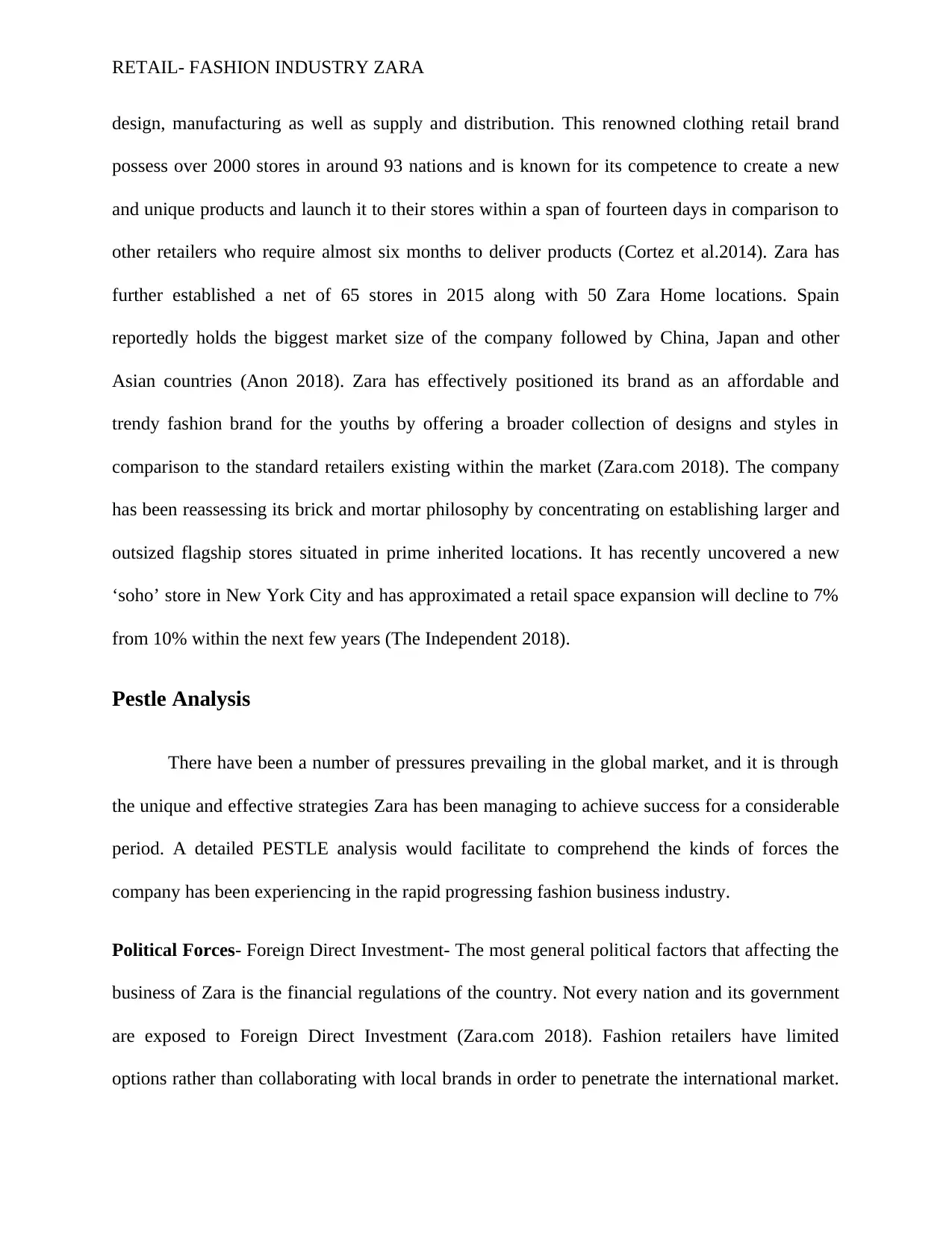
RETAIL- FASHION INDUSTRY ZARA
design, manufacturing as well as supply and distribution. This renowned clothing retail brand
possess over 2000 stores in around 93 nations and is known for its competence to create a new
and unique products and launch it to their stores within a span of fourteen days in comparison to
other retailers who require almost six months to deliver products (Cortez et al.2014). Zara has
further established a net of 65 stores in 2015 along with 50 Zara Home locations. Spain
reportedly holds the biggest market size of the company followed by China, Japan and other
Asian countries (Anon 2018). Zara has effectively positioned its brand as an affordable and
trendy fashion brand for the youths by offering a broader collection of designs and styles in
comparison to the standard retailers existing within the market (Zara.com 2018). The company
has been reassessing its brick and mortar philosophy by concentrating on establishing larger and
outsized flagship stores situated in prime inherited locations. It has recently uncovered a new
‘soho’ store in New York City and has approximated a retail space expansion will decline to 7%
from 10% within the next few years (The Independent 2018).
Pestle Analysis
There have been a number of pressures prevailing in the global market, and it is through
the unique and effective strategies Zara has been managing to achieve success for a considerable
period. A detailed PESTLE analysis would facilitate to comprehend the kinds of forces the
company has been experiencing in the rapid progressing fashion business industry.
Political Forces- Foreign Direct Investment- The most general political factors that affecting the
business of Zara is the financial regulations of the country. Not every nation and its government
are exposed to Foreign Direct Investment (Zara.com 2018). Fashion retailers have limited
options rather than collaborating with local brands in order to penetrate the international market.
design, manufacturing as well as supply and distribution. This renowned clothing retail brand
possess over 2000 stores in around 93 nations and is known for its competence to create a new
and unique products and launch it to their stores within a span of fourteen days in comparison to
other retailers who require almost six months to deliver products (Cortez et al.2014). Zara has
further established a net of 65 stores in 2015 along with 50 Zara Home locations. Spain
reportedly holds the biggest market size of the company followed by China, Japan and other
Asian countries (Anon 2018). Zara has effectively positioned its brand as an affordable and
trendy fashion brand for the youths by offering a broader collection of designs and styles in
comparison to the standard retailers existing within the market (Zara.com 2018). The company
has been reassessing its brick and mortar philosophy by concentrating on establishing larger and
outsized flagship stores situated in prime inherited locations. It has recently uncovered a new
‘soho’ store in New York City and has approximated a retail space expansion will decline to 7%
from 10% within the next few years (The Independent 2018).
Pestle Analysis
There have been a number of pressures prevailing in the global market, and it is through
the unique and effective strategies Zara has been managing to achieve success for a considerable
period. A detailed PESTLE analysis would facilitate to comprehend the kinds of forces the
company has been experiencing in the rapid progressing fashion business industry.
Political Forces- Foreign Direct Investment- The most general political factors that affecting the
business of Zara is the financial regulations of the country. Not every nation and its government
are exposed to Foreign Direct Investment (Zara.com 2018). Fashion retailers have limited
options rather than collaborating with local brands in order to penetrate the international market.
Secure Best Marks with AI Grader
Need help grading? Try our AI Grader for instant feedback on your assignments.
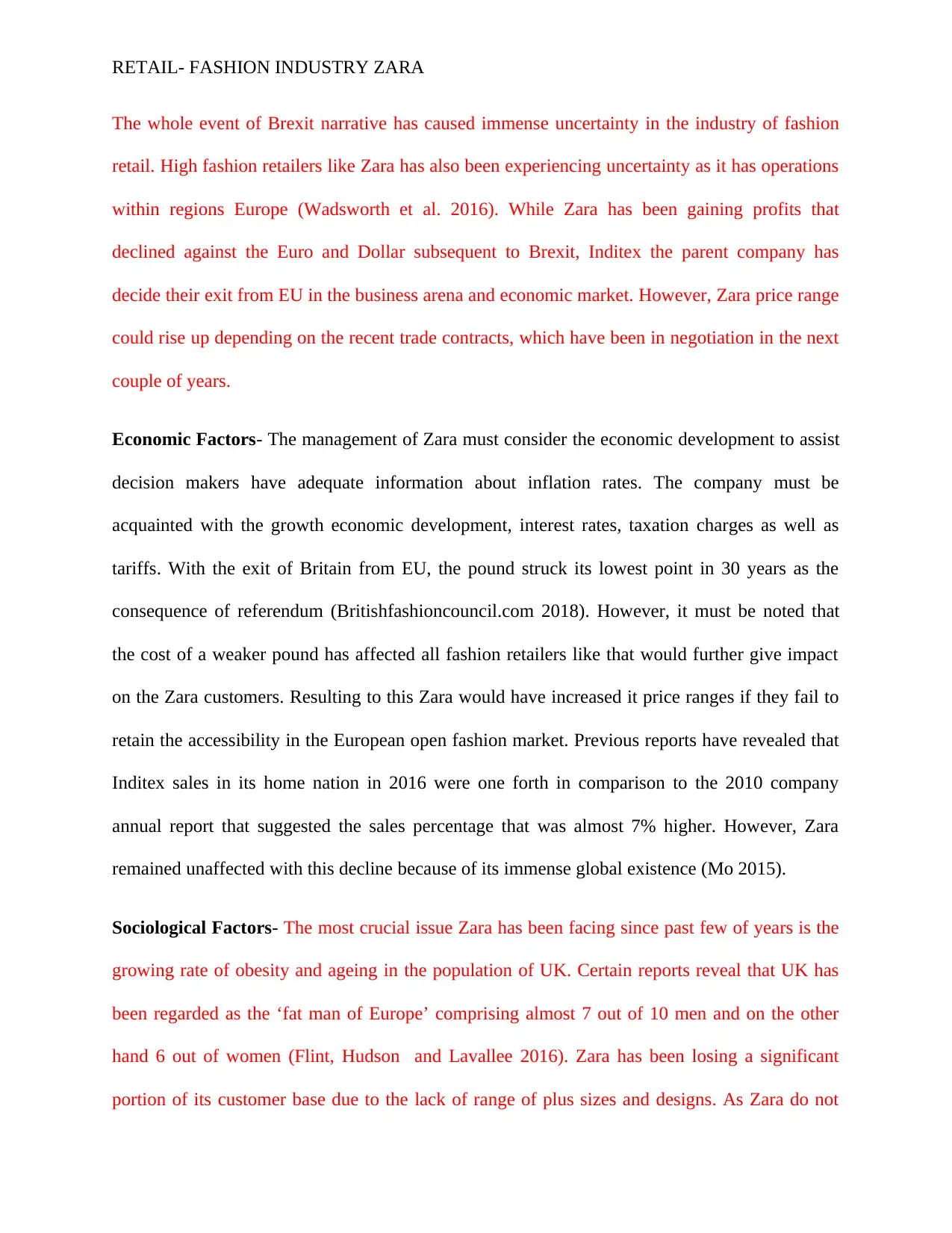
RETAIL- FASHION INDUSTRY ZARA
The whole event of Brexit narrative has caused immense uncertainty in the industry of fashion
retail. High fashion retailers like Zara has also been experiencing uncertainty as it has operations
within regions Europe (Wadsworth et al. 2016). While Zara has been gaining profits that
declined against the Euro and Dollar subsequent to Brexit, Inditex the parent company has
decide their exit from EU in the business arena and economic market. However, Zara price range
could rise up depending on the recent trade contracts, which have been in negotiation in the next
couple of years.
Economic Factors- The management of Zara must consider the economic development to assist
decision makers have adequate information about inflation rates. The company must be
acquainted with the growth economic development, interest rates, taxation charges as well as
tariffs. With the exit of Britain from EU, the pound struck its lowest point in 30 years as the
consequence of referendum (Britishfashioncouncil.com 2018). However, it must be noted that
the cost of a weaker pound has affected all fashion retailers like that would further give impact
on the Zara customers. Resulting to this Zara would have increased it price ranges if they fail to
retain the accessibility in the European open fashion market. Previous reports have revealed that
Inditex sales in its home nation in 2016 were one forth in comparison to the 2010 company
annual report that suggested the sales percentage that was almost 7% higher. However, Zara
remained unaffected with this decline because of its immense global existence (Mo 2015).
Sociological Factors- The most crucial issue Zara has been facing since past few of years is the
growing rate of obesity and ageing in the population of UK. Certain reports reveal that UK has
been regarded as the ‘fat man of Europe’ comprising almost 7 out of 10 men and on the other
hand 6 out of women (Flint, Hudson and Lavallee 2016). Zara has been losing a significant
portion of its customer base due to the lack of range of plus sizes and designs. As Zara do not
The whole event of Brexit narrative has caused immense uncertainty in the industry of fashion
retail. High fashion retailers like Zara has also been experiencing uncertainty as it has operations
within regions Europe (Wadsworth et al. 2016). While Zara has been gaining profits that
declined against the Euro and Dollar subsequent to Brexit, Inditex the parent company has
decide their exit from EU in the business arena and economic market. However, Zara price range
could rise up depending on the recent trade contracts, which have been in negotiation in the next
couple of years.
Economic Factors- The management of Zara must consider the economic development to assist
decision makers have adequate information about inflation rates. The company must be
acquainted with the growth economic development, interest rates, taxation charges as well as
tariffs. With the exit of Britain from EU, the pound struck its lowest point in 30 years as the
consequence of referendum (Britishfashioncouncil.com 2018). However, it must be noted that
the cost of a weaker pound has affected all fashion retailers like that would further give impact
on the Zara customers. Resulting to this Zara would have increased it price ranges if they fail to
retain the accessibility in the European open fashion market. Previous reports have revealed that
Inditex sales in its home nation in 2016 were one forth in comparison to the 2010 company
annual report that suggested the sales percentage that was almost 7% higher. However, Zara
remained unaffected with this decline because of its immense global existence (Mo 2015).
Sociological Factors- The most crucial issue Zara has been facing since past few of years is the
growing rate of obesity and ageing in the population of UK. Certain reports reveal that UK has
been regarded as the ‘fat man of Europe’ comprising almost 7 out of 10 men and on the other
hand 6 out of women (Flint, Hudson and Lavallee 2016). Zara has been losing a significant
portion of its customer base due to the lack of range of plus sizes and designs. As Zara do not
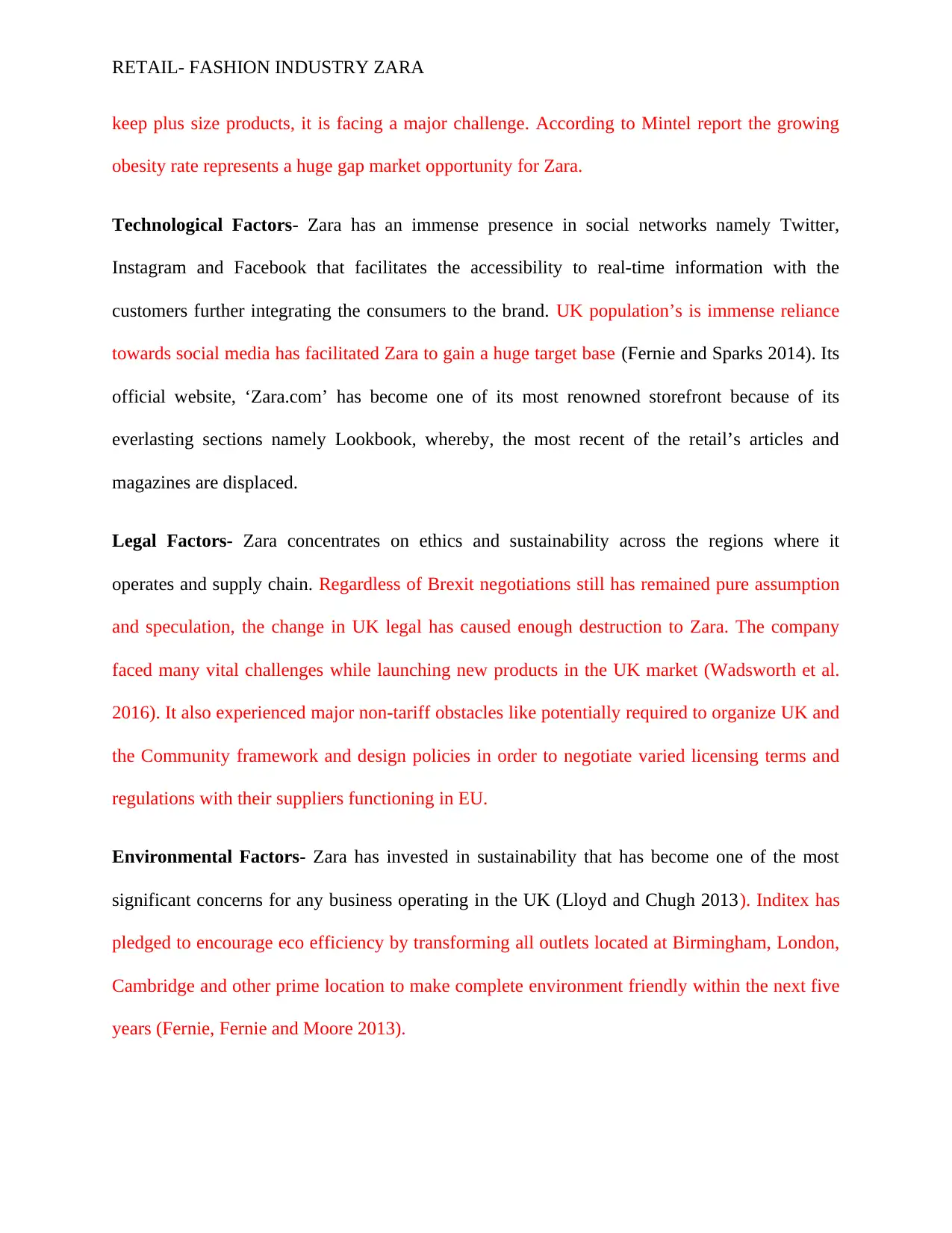
RETAIL- FASHION INDUSTRY ZARA
keep plus size products, it is facing a major challenge. According to Mintel report the growing
obesity rate represents a huge gap market opportunity for Zara.
Technological Factors- Zara has an immense presence in social networks namely Twitter,
Instagram and Facebook that facilitates the accessibility to real-time information with the
customers further integrating the consumers to the brand. UK population’s is immense reliance
towards social media has facilitated Zara to gain a huge target base (Fernie and Sparks 2014). Its
official website, ‘Zara.com’ has become one of its most renowned storefront because of its
everlasting sections namely Lookbook, whereby, the most recent of the retail’s articles and
magazines are displaced.
Legal Factors- Zara concentrates on ethics and sustainability across the regions where it
operates and supply chain. Regardless of Brexit negotiations still has remained pure assumption
and speculation, the change in UK legal has caused enough destruction to Zara. The company
faced many vital challenges while launching new products in the UK market (Wadsworth et al.
2016). It also experienced major non-tariff obstacles like potentially required to organize UK and
the Community framework and design policies in order to negotiate varied licensing terms and
regulations with their suppliers functioning in EU.
Environmental Factors- Zara has invested in sustainability that has become one of the most
significant concerns for any business operating in the UK (Lloyd and Chugh 2013). Inditex has
pledged to encourage eco efficiency by transforming all outlets located at Birmingham, London,
Cambridge and other prime location to make complete environment friendly within the next five
years (Fernie, Fernie and Moore 2013).
keep plus size products, it is facing a major challenge. According to Mintel report the growing
obesity rate represents a huge gap market opportunity for Zara.
Technological Factors- Zara has an immense presence in social networks namely Twitter,
Instagram and Facebook that facilitates the accessibility to real-time information with the
customers further integrating the consumers to the brand. UK population’s is immense reliance
towards social media has facilitated Zara to gain a huge target base (Fernie and Sparks 2014). Its
official website, ‘Zara.com’ has become one of its most renowned storefront because of its
everlasting sections namely Lookbook, whereby, the most recent of the retail’s articles and
magazines are displaced.
Legal Factors- Zara concentrates on ethics and sustainability across the regions where it
operates and supply chain. Regardless of Brexit negotiations still has remained pure assumption
and speculation, the change in UK legal has caused enough destruction to Zara. The company
faced many vital challenges while launching new products in the UK market (Wadsworth et al.
2016). It also experienced major non-tariff obstacles like potentially required to organize UK and
the Community framework and design policies in order to negotiate varied licensing terms and
regulations with their suppliers functioning in EU.
Environmental Factors- Zara has invested in sustainability that has become one of the most
significant concerns for any business operating in the UK (Lloyd and Chugh 2013). Inditex has
pledged to encourage eco efficiency by transforming all outlets located at Birmingham, London,
Cambridge and other prime location to make complete environment friendly within the next five
years (Fernie, Fernie and Moore 2013).
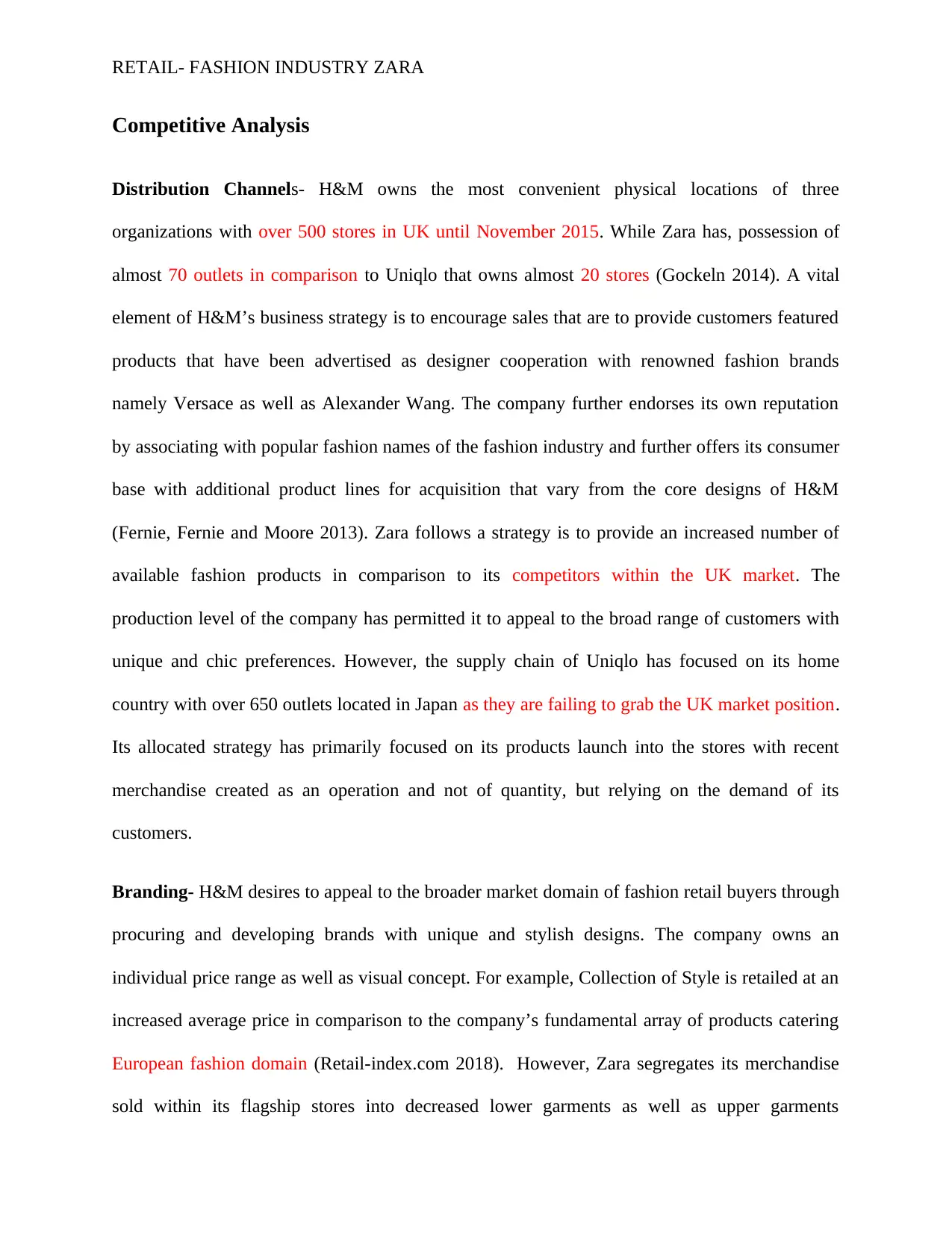
RETAIL- FASHION INDUSTRY ZARA
Competitive Analysis
Distribution Channels- H&M owns the most convenient physical locations of three
organizations with over 500 stores in UK until November 2015. While Zara has, possession of
almost 70 outlets in comparison to Uniqlo that owns almost 20 stores (Gockeln 2014). A vital
element of H&M’s business strategy is to encourage sales that are to provide customers featured
products that have been advertised as designer cooperation with renowned fashion brands
namely Versace as well as Alexander Wang. The company further endorses its own reputation
by associating with popular fashion names of the fashion industry and further offers its consumer
base with additional product lines for acquisition that vary from the core designs of H&M
(Fernie, Fernie and Moore 2013). Zara follows a strategy is to provide an increased number of
available fashion products in comparison to its competitors within the UK market. The
production level of the company has permitted it to appeal to the broad range of customers with
unique and chic preferences. However, the supply chain of Uniqlo has focused on its home
country with over 650 outlets located in Japan as they are failing to grab the UK market position.
Its allocated strategy has primarily focused on its products launch into the stores with recent
merchandise created as an operation and not of quantity, but relying on the demand of its
customers.
Branding- H&M desires to appeal to the broader market domain of fashion retail buyers through
procuring and developing brands with unique and stylish designs. The company owns an
individual price range as well as visual concept. For example, Collection of Style is retailed at an
increased average price in comparison to the company’s fundamental array of products catering
European fashion domain (Retail-index.com 2018). However, Zara segregates its merchandise
sold within its flagship stores into decreased lower garments as well as upper garments
Competitive Analysis
Distribution Channels- H&M owns the most convenient physical locations of three
organizations with over 500 stores in UK until November 2015. While Zara has, possession of
almost 70 outlets in comparison to Uniqlo that owns almost 20 stores (Gockeln 2014). A vital
element of H&M’s business strategy is to encourage sales that are to provide customers featured
products that have been advertised as designer cooperation with renowned fashion brands
namely Versace as well as Alexander Wang. The company further endorses its own reputation
by associating with popular fashion names of the fashion industry and further offers its consumer
base with additional product lines for acquisition that vary from the core designs of H&M
(Fernie, Fernie and Moore 2013). Zara follows a strategy is to provide an increased number of
available fashion products in comparison to its competitors within the UK market. The
production level of the company has permitted it to appeal to the broad range of customers with
unique and chic preferences. However, the supply chain of Uniqlo has focused on its home
country with over 650 outlets located in Japan as they are failing to grab the UK market position.
Its allocated strategy has primarily focused on its products launch into the stores with recent
merchandise created as an operation and not of quantity, but relying on the demand of its
customers.
Branding- H&M desires to appeal to the broader market domain of fashion retail buyers through
procuring and developing brands with unique and stylish designs. The company owns an
individual price range as well as visual concept. For example, Collection of Style is retailed at an
increased average price in comparison to the company’s fundamental array of products catering
European fashion domain (Retail-index.com 2018). However, Zara segregates its merchandise
sold within its flagship stores into decreased lower garments as well as upper garments
Paraphrase This Document
Need a fresh take? Get an instant paraphrase of this document with our AI Paraphraser
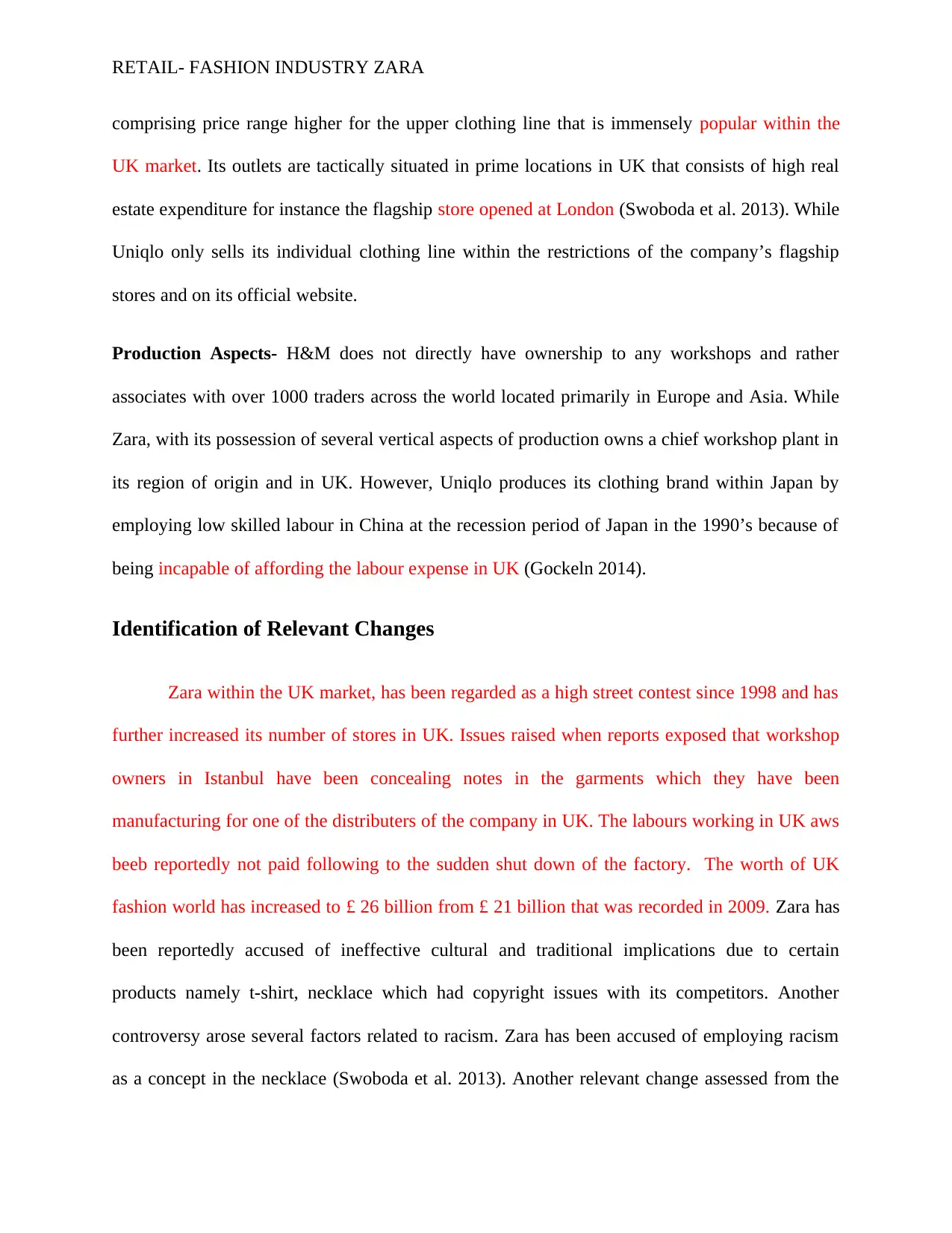
RETAIL- FASHION INDUSTRY ZARA
comprising price range higher for the upper clothing line that is immensely popular within the
UK market. Its outlets are tactically situated in prime locations in UK that consists of high real
estate expenditure for instance the flagship store opened at London (Swoboda et al. 2013). While
Uniqlo only sells its individual clothing line within the restrictions of the company’s flagship
stores and on its official website.
Production Aspects- H&M does not directly have ownership to any workshops and rather
associates with over 1000 traders across the world located primarily in Europe and Asia. While
Zara, with its possession of several vertical aspects of production owns a chief workshop plant in
its region of origin and in UK. However, Uniqlo produces its clothing brand within Japan by
employing low skilled labour in China at the recession period of Japan in the 1990’s because of
being incapable of affording the labour expense in UK (Gockeln 2014).
Identification of Relevant Changes
Zara within the UK market, has been regarded as a high street contest since 1998 and has
further increased its number of stores in UK. Issues raised when reports exposed that workshop
owners in Istanbul have been concealing notes in the garments which they have been
manufacturing for one of the distributers of the company in UK. The labours working in UK aws
beeb reportedly not paid following to the sudden shut down of the factory. The worth of UK
fashion world has increased to £ 26 billion from £ 21 billion that was recorded in 2009. Zara has
been reportedly accused of ineffective cultural and traditional implications due to certain
products namely t-shirt, necklace which had copyright issues with its competitors. Another
controversy arose several factors related to racism. Zara has been accused of employing racism
as a concept in the necklace (Swoboda et al. 2013). Another relevant change assessed from the
comprising price range higher for the upper clothing line that is immensely popular within the
UK market. Its outlets are tactically situated in prime locations in UK that consists of high real
estate expenditure for instance the flagship store opened at London (Swoboda et al. 2013). While
Uniqlo only sells its individual clothing line within the restrictions of the company’s flagship
stores and on its official website.
Production Aspects- H&M does not directly have ownership to any workshops and rather
associates with over 1000 traders across the world located primarily in Europe and Asia. While
Zara, with its possession of several vertical aspects of production owns a chief workshop plant in
its region of origin and in UK. However, Uniqlo produces its clothing brand within Japan by
employing low skilled labour in China at the recession period of Japan in the 1990’s because of
being incapable of affording the labour expense in UK (Gockeln 2014).
Identification of Relevant Changes
Zara within the UK market, has been regarded as a high street contest since 1998 and has
further increased its number of stores in UK. Issues raised when reports exposed that workshop
owners in Istanbul have been concealing notes in the garments which they have been
manufacturing for one of the distributers of the company in UK. The labours working in UK aws
beeb reportedly not paid following to the sudden shut down of the factory. The worth of UK
fashion world has increased to £ 26 billion from £ 21 billion that was recorded in 2009. Zara has
been reportedly accused of ineffective cultural and traditional implications due to certain
products namely t-shirt, necklace which had copyright issues with its competitors. Another
controversy arose several factors related to racism. Zara has been accused of employing racism
as a concept in the necklace (Swoboda et al. 2013). Another relevant change assessed from the
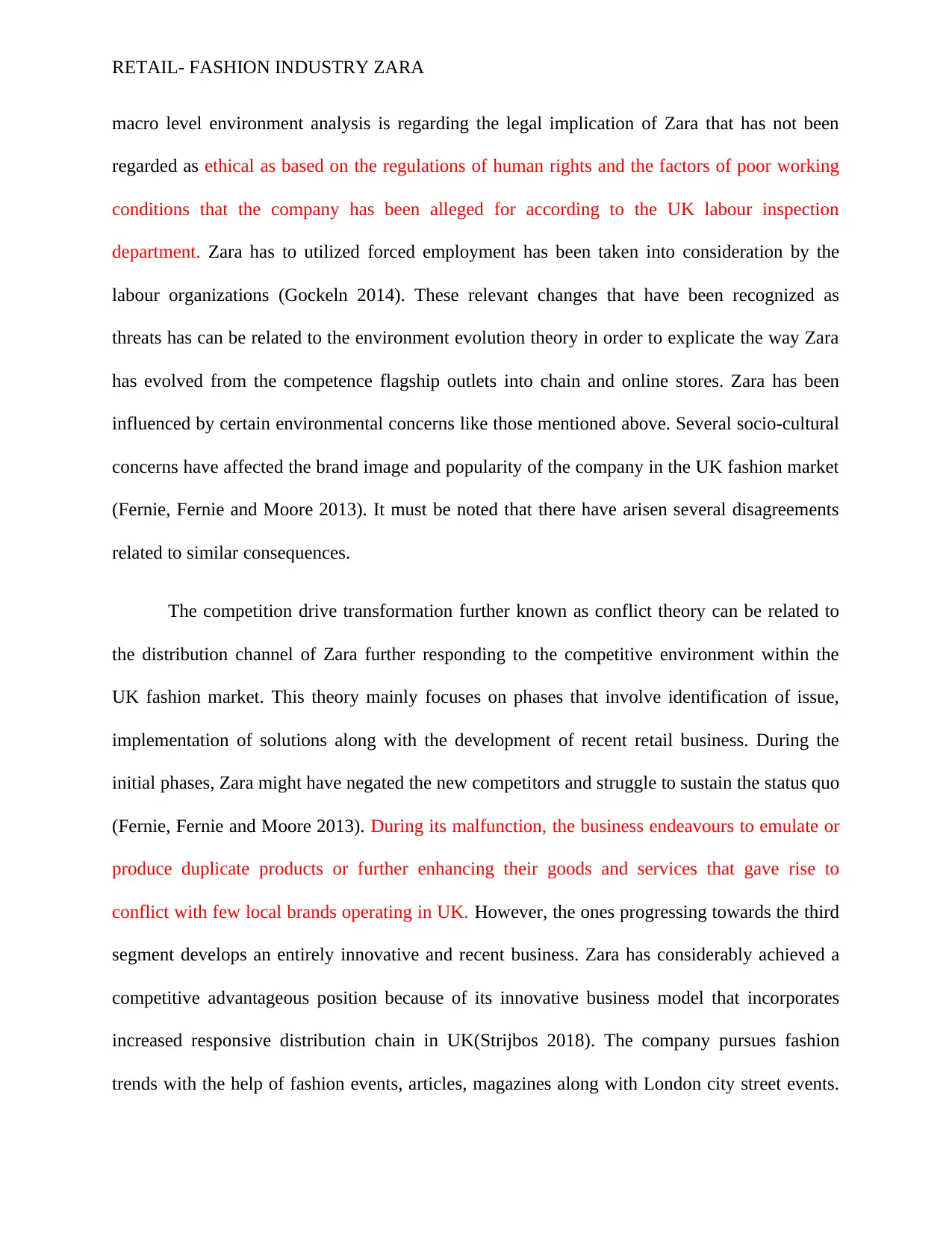
RETAIL- FASHION INDUSTRY ZARA
macro level environment analysis is regarding the legal implication of Zara that has not been
regarded as ethical as based on the regulations of human rights and the factors of poor working
conditions that the company has been alleged for according to the UK labour inspection
department. Zara has to utilized forced employment has been taken into consideration by the
labour organizations (Gockeln 2014). These relevant changes that have been recognized as
threats has can be related to the environment evolution theory in order to explicate the way Zara
has evolved from the competence flagship outlets into chain and online stores. Zara has been
influenced by certain environmental concerns like those mentioned above. Several socio-cultural
concerns have affected the brand image and popularity of the company in the UK fashion market
(Fernie, Fernie and Moore 2013). It must be noted that there have arisen several disagreements
related to similar consequences.
The competition drive transformation further known as conflict theory can be related to
the distribution channel of Zara further responding to the competitive environment within the
UK fashion market. This theory mainly focuses on phases that involve identification of issue,
implementation of solutions along with the development of recent retail business. During the
initial phases, Zara might have negated the new competitors and struggle to sustain the status quo
(Fernie, Fernie and Moore 2013). During its malfunction, the business endeavours to emulate or
produce duplicate products or further enhancing their goods and services that gave rise to
conflict with few local brands operating in UK. However, the ones progressing towards the third
segment develops an entirely innovative and recent business. Zara has considerably achieved a
competitive advantageous position because of its innovative business model that incorporates
increased responsive distribution chain in UK(Strijbos 2018). The company pursues fashion
trends with the help of fashion events, articles, magazines along with London city street events.
macro level environment analysis is regarding the legal implication of Zara that has not been
regarded as ethical as based on the regulations of human rights and the factors of poor working
conditions that the company has been alleged for according to the UK labour inspection
department. Zara has to utilized forced employment has been taken into consideration by the
labour organizations (Gockeln 2014). These relevant changes that have been recognized as
threats has can be related to the environment evolution theory in order to explicate the way Zara
has evolved from the competence flagship outlets into chain and online stores. Zara has been
influenced by certain environmental concerns like those mentioned above. Several socio-cultural
concerns have affected the brand image and popularity of the company in the UK fashion market
(Fernie, Fernie and Moore 2013). It must be noted that there have arisen several disagreements
related to similar consequences.
The competition drive transformation further known as conflict theory can be related to
the distribution channel of Zara further responding to the competitive environment within the
UK fashion market. This theory mainly focuses on phases that involve identification of issue,
implementation of solutions along with the development of recent retail business. During the
initial phases, Zara might have negated the new competitors and struggle to sustain the status quo
(Fernie, Fernie and Moore 2013). During its malfunction, the business endeavours to emulate or
produce duplicate products or further enhancing their goods and services that gave rise to
conflict with few local brands operating in UK. However, the ones progressing towards the third
segment develops an entirely innovative and recent business. Zara has considerably achieved a
competitive advantageous position because of its innovative business model that incorporates
increased responsive distribution chain in UK(Strijbos 2018). The company pursues fashion
trends with the help of fashion events, articles, magazines along with London city street events.
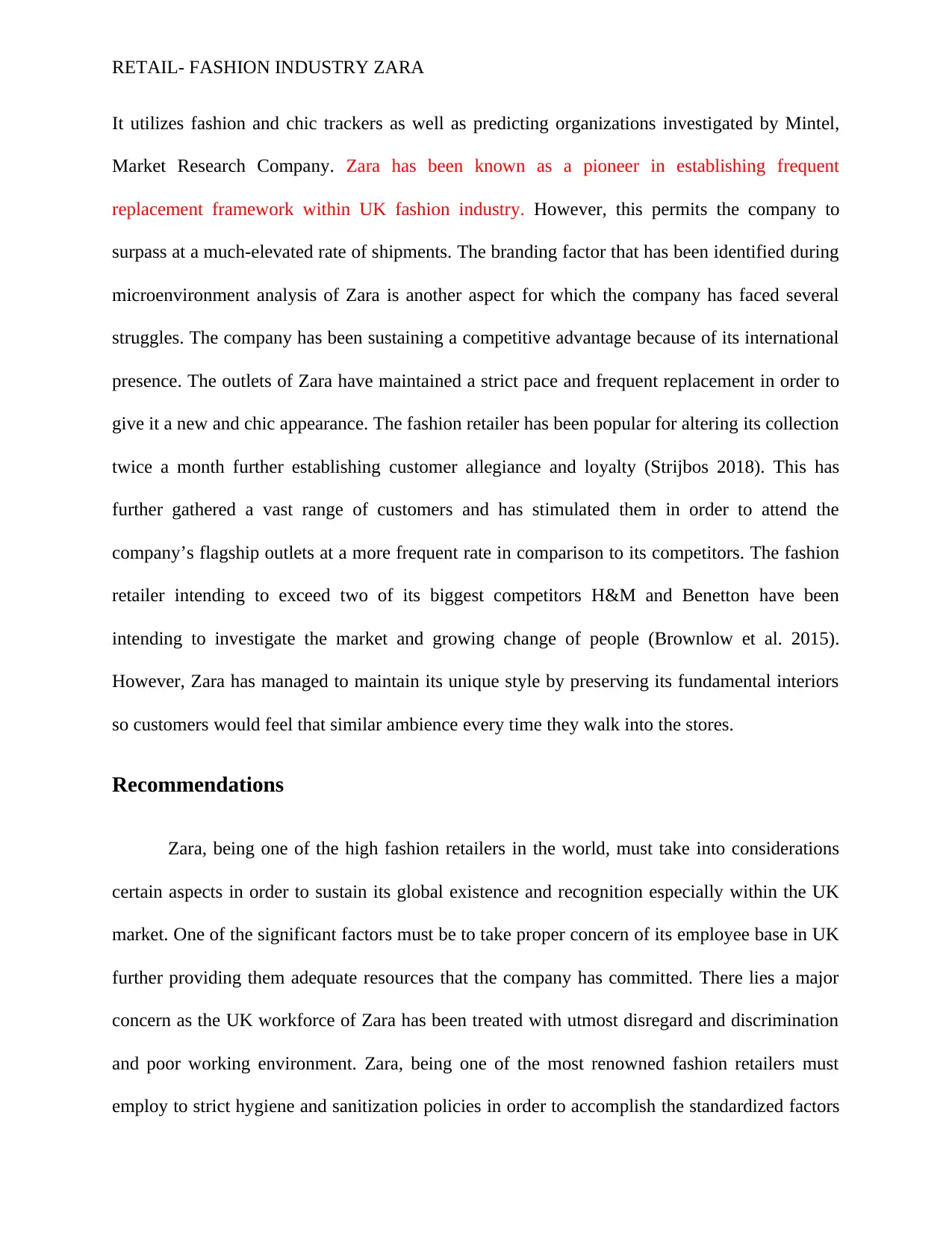
RETAIL- FASHION INDUSTRY ZARA
It utilizes fashion and chic trackers as well as predicting organizations investigated by Mintel,
Market Research Company. Zara has been known as a pioneer in establishing frequent
replacement framework within UK fashion industry. However, this permits the company to
surpass at a much-elevated rate of shipments. The branding factor that has been identified during
microenvironment analysis of Zara is another aspect for which the company has faced several
struggles. The company has been sustaining a competitive advantage because of its international
presence. The outlets of Zara have maintained a strict pace and frequent replacement in order to
give it a new and chic appearance. The fashion retailer has been popular for altering its collection
twice a month further establishing customer allegiance and loyalty (Strijbos 2018). This has
further gathered a vast range of customers and has stimulated them in order to attend the
company’s flagship outlets at a more frequent rate in comparison to its competitors. The fashion
retailer intending to exceed two of its biggest competitors H&M and Benetton have been
intending to investigate the market and growing change of people (Brownlow et al. 2015).
However, Zara has managed to maintain its unique style by preserving its fundamental interiors
so customers would feel that similar ambience every time they walk into the stores.
Recommendations
Zara, being one of the high fashion retailers in the world, must take into considerations
certain aspects in order to sustain its global existence and recognition especially within the UK
market. One of the significant factors must be to take proper concern of its employee base in UK
further providing them adequate resources that the company has committed. There lies a major
concern as the UK workforce of Zara has been treated with utmost disregard and discrimination
and poor working environment. Zara, being one of the most renowned fashion retailers must
employ to strict hygiene and sanitization policies in order to accomplish the standardized factors
It utilizes fashion and chic trackers as well as predicting organizations investigated by Mintel,
Market Research Company. Zara has been known as a pioneer in establishing frequent
replacement framework within UK fashion industry. However, this permits the company to
surpass at a much-elevated rate of shipments. The branding factor that has been identified during
microenvironment analysis of Zara is another aspect for which the company has faced several
struggles. The company has been sustaining a competitive advantage because of its international
presence. The outlets of Zara have maintained a strict pace and frequent replacement in order to
give it a new and chic appearance. The fashion retailer has been popular for altering its collection
twice a month further establishing customer allegiance and loyalty (Strijbos 2018). This has
further gathered a vast range of customers and has stimulated them in order to attend the
company’s flagship outlets at a more frequent rate in comparison to its competitors. The fashion
retailer intending to exceed two of its biggest competitors H&M and Benetton have been
intending to investigate the market and growing change of people (Brownlow et al. 2015).
However, Zara has managed to maintain its unique style by preserving its fundamental interiors
so customers would feel that similar ambience every time they walk into the stores.
Recommendations
Zara, being one of the high fashion retailers in the world, must take into considerations
certain aspects in order to sustain its global existence and recognition especially within the UK
market. One of the significant factors must be to take proper concern of its employee base in UK
further providing them adequate resources that the company has committed. There lies a major
concern as the UK workforce of Zara has been treated with utmost disregard and discrimination
and poor working environment. Zara, being one of the most renowned fashion retailers must
employ to strict hygiene and sanitization policies in order to accomplish the standardized factors
Secure Best Marks with AI Grader
Need help grading? Try our AI Grader for instant feedback on your assignments.
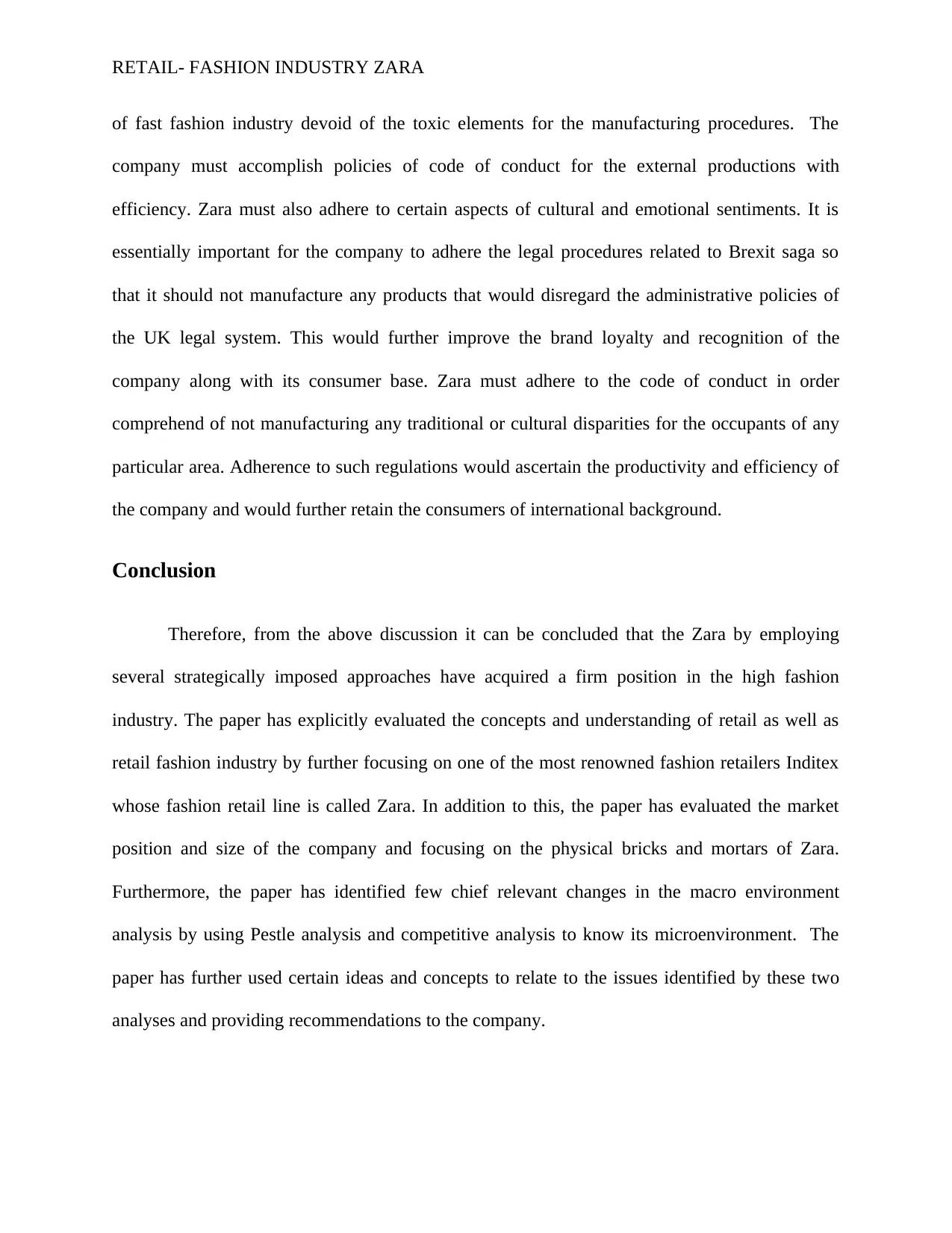
RETAIL- FASHION INDUSTRY ZARA
of fast fashion industry devoid of the toxic elements for the manufacturing procedures. The
company must accomplish policies of code of conduct for the external productions with
efficiency. Zara must also adhere to certain aspects of cultural and emotional sentiments. It is
essentially important for the company to adhere the legal procedures related to Brexit saga so
that it should not manufacture any products that would disregard the administrative policies of
the UK legal system. This would further improve the brand loyalty and recognition of the
company along with its consumer base. Zara must adhere to the code of conduct in order
comprehend of not manufacturing any traditional or cultural disparities for the occupants of any
particular area. Adherence to such regulations would ascertain the productivity and efficiency of
the company and would further retain the consumers of international background.
Conclusion
Therefore, from the above discussion it can be concluded that the Zara by employing
several strategically imposed approaches have acquired a firm position in the high fashion
industry. The paper has explicitly evaluated the concepts and understanding of retail as well as
retail fashion industry by further focusing on one of the most renowned fashion retailers Inditex
whose fashion retail line is called Zara. In addition to this, the paper has evaluated the market
position and size of the company and focusing on the physical bricks and mortars of Zara.
Furthermore, the paper has identified few chief relevant changes in the macro environment
analysis by using Pestle analysis and competitive analysis to know its microenvironment. The
paper has further used certain ideas and concepts to relate to the issues identified by these two
analyses and providing recommendations to the company.
of fast fashion industry devoid of the toxic elements for the manufacturing procedures. The
company must accomplish policies of code of conduct for the external productions with
efficiency. Zara must also adhere to certain aspects of cultural and emotional sentiments. It is
essentially important for the company to adhere the legal procedures related to Brexit saga so
that it should not manufacture any products that would disregard the administrative policies of
the UK legal system. This would further improve the brand loyalty and recognition of the
company along with its consumer base. Zara must adhere to the code of conduct in order
comprehend of not manufacturing any traditional or cultural disparities for the occupants of any
particular area. Adherence to such regulations would ascertain the productivity and efficiency of
the company and would further retain the consumers of international background.
Conclusion
Therefore, from the above discussion it can be concluded that the Zara by employing
several strategically imposed approaches have acquired a firm position in the high fashion
industry. The paper has explicitly evaluated the concepts and understanding of retail as well as
retail fashion industry by further focusing on one of the most renowned fashion retailers Inditex
whose fashion retail line is called Zara. In addition to this, the paper has evaluated the market
position and size of the company and focusing on the physical bricks and mortars of Zara.
Furthermore, the paper has identified few chief relevant changes in the macro environment
analysis by using Pestle analysis and competitive analysis to know its microenvironment. The
paper has further used certain ideas and concepts to relate to the issues identified by these two
analyses and providing recommendations to the company.
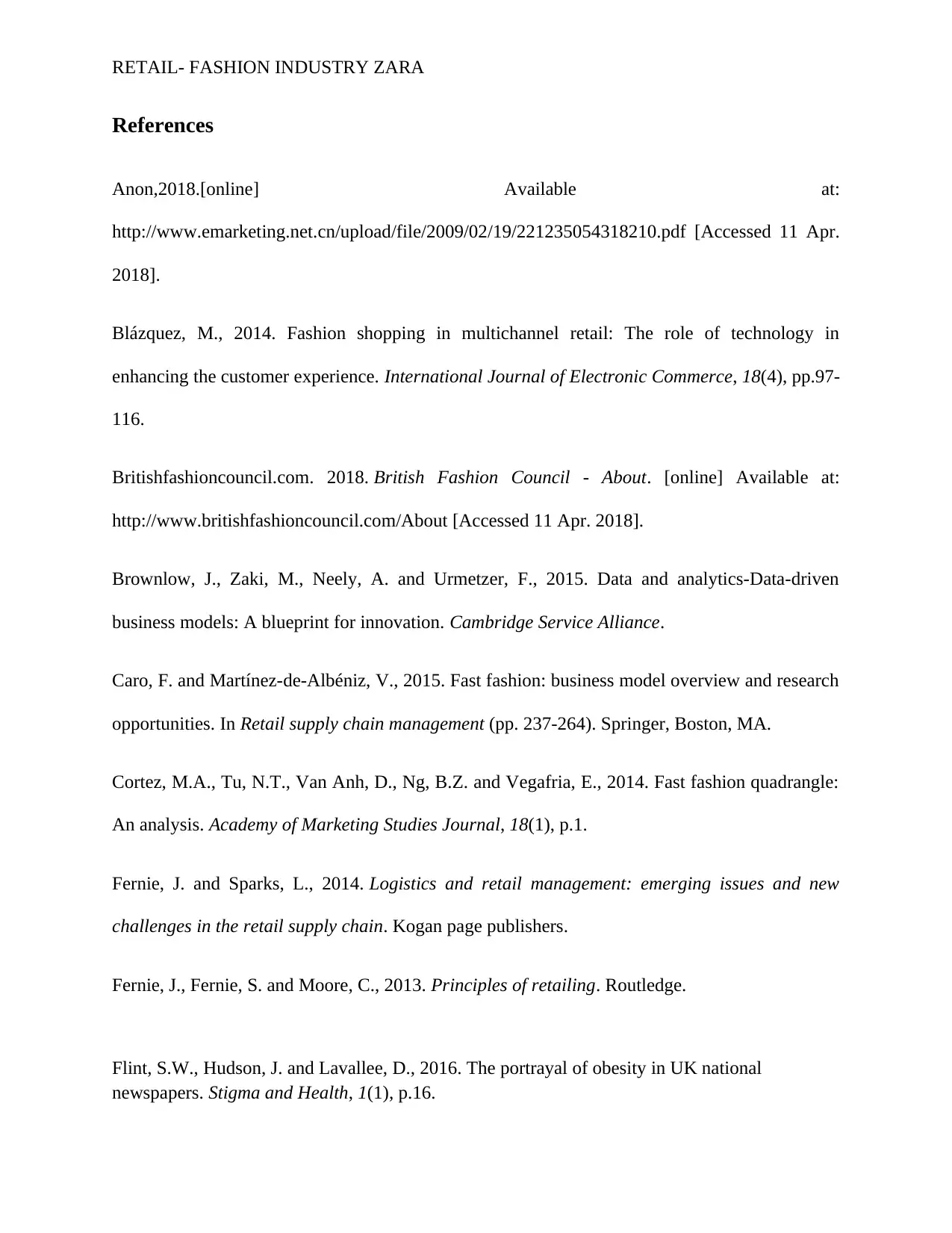
RETAIL- FASHION INDUSTRY ZARA
References
Anon,2018.[online] Available at:
http://www.emarketing.net.cn/upload/file/2009/02/19/221235054318210.pdf [Accessed 11 Apr.
2018].
Blázquez, M., 2014. Fashion shopping in multichannel retail: The role of technology in
enhancing the customer experience. International Journal of Electronic Commerce, 18(4), pp.97-
116.
Britishfashioncouncil.com. 2018. British Fashion Council - About. [online] Available at:
http://www.britishfashioncouncil.com/About [Accessed 11 Apr. 2018].
Brownlow, J., Zaki, M., Neely, A. and Urmetzer, F., 2015. Data and analytics-Data-driven
business models: A blueprint for innovation. Cambridge Service Alliance.
Caro, F. and Martínez-de-Albéniz, V., 2015. Fast fashion: business model overview and research
opportunities. In Retail supply chain management (pp. 237-264). Springer, Boston, MA.
Cortez, M.A., Tu, N.T., Van Anh, D., Ng, B.Z. and Vegafria, E., 2014. Fast fashion quadrangle:
An analysis. Academy of Marketing Studies Journal, 18(1), p.1.
Fernie, J. and Sparks, L., 2014. Logistics and retail management: emerging issues and new
challenges in the retail supply chain. Kogan page publishers.
Fernie, J., Fernie, S. and Moore, C., 2013. Principles of retailing. Routledge.
Flint, S.W., Hudson, J. and Lavallee, D., 2016. The portrayal of obesity in UK national
newspapers. Stigma and Health, 1(1), p.16.
References
Anon,2018.[online] Available at:
http://www.emarketing.net.cn/upload/file/2009/02/19/221235054318210.pdf [Accessed 11 Apr.
2018].
Blázquez, M., 2014. Fashion shopping in multichannel retail: The role of technology in
enhancing the customer experience. International Journal of Electronic Commerce, 18(4), pp.97-
116.
Britishfashioncouncil.com. 2018. British Fashion Council - About. [online] Available at:
http://www.britishfashioncouncil.com/About [Accessed 11 Apr. 2018].
Brownlow, J., Zaki, M., Neely, A. and Urmetzer, F., 2015. Data and analytics-Data-driven
business models: A blueprint for innovation. Cambridge Service Alliance.
Caro, F. and Martínez-de-Albéniz, V., 2015. Fast fashion: business model overview and research
opportunities. In Retail supply chain management (pp. 237-264). Springer, Boston, MA.
Cortez, M.A., Tu, N.T., Van Anh, D., Ng, B.Z. and Vegafria, E., 2014. Fast fashion quadrangle:
An analysis. Academy of Marketing Studies Journal, 18(1), p.1.
Fernie, J. and Sparks, L., 2014. Logistics and retail management: emerging issues and new
challenges in the retail supply chain. Kogan page publishers.
Fernie, J., Fernie, S. and Moore, C., 2013. Principles of retailing. Routledge.
Flint, S.W., Hudson, J. and Lavallee, D., 2016. The portrayal of obesity in UK national
newspapers. Stigma and Health, 1(1), p.16.

RETAIL- FASHION INDUSTRY ZARA
Gockeln, L., 2014. Fashion industry analysis from the perspective of business model
dynamics (Bachelor's thesis, University of Twente).
Jary, M. and Wileman, A., 2016. Retail power plays: From trading to brand leadership.
Springer.
Kantarworldpanel.com. 2018. Fashion - English - Kantar Worldpanel. [online] Available at:
https://www.kantarworldpanel.com/en/Consumer-Panels-/Fashion [Accessed 11 Apr. 2018].
Lloyd, E. and Chugh, G.,2013. Master of Business Administration Assignment Cover Sheet.
Miller, K., 2013. Hedonic customer responses to fast fashion and replicas. Journal of Fashion
Marketing and Management: An International Journal, 17(2), pp.160-174.
Mo, Z., 2015. Internationalization process of fast fashion retailers: evidence of H&M and
Zara. International Journal of Business and Management, 10(3), p.217.
Nenni, M.E., Giustiniano, L. and Pirolo, L., 2013. Demand forecasting in the fashion industry: a
review. International Journal of Engineering Business Management, 5, p.37.
Retail-index.com. 2018. Fashion & Clothing Retailers in Europe. [online] Available at:
http://www.retail-index.com/Sectors/FashionClothingRetailersinEurope.aspx [Accessed 11 Apr.
2018].
Strijbos, B. 2018. UK fashion industry statistics. [online] Fashionunited.uk. Available at:
https://fashionunited.uk/uk-fashion-industry-statistics [Accessed 11 Apr. 2018].
Gockeln, L., 2014. Fashion industry analysis from the perspective of business model
dynamics (Bachelor's thesis, University of Twente).
Jary, M. and Wileman, A., 2016. Retail power plays: From trading to brand leadership.
Springer.
Kantarworldpanel.com. 2018. Fashion - English - Kantar Worldpanel. [online] Available at:
https://www.kantarworldpanel.com/en/Consumer-Panels-/Fashion [Accessed 11 Apr. 2018].
Lloyd, E. and Chugh, G.,2013. Master of Business Administration Assignment Cover Sheet.
Miller, K., 2013. Hedonic customer responses to fast fashion and replicas. Journal of Fashion
Marketing and Management: An International Journal, 17(2), pp.160-174.
Mo, Z., 2015. Internationalization process of fast fashion retailers: evidence of H&M and
Zara. International Journal of Business and Management, 10(3), p.217.
Nenni, M.E., Giustiniano, L. and Pirolo, L., 2013. Demand forecasting in the fashion industry: a
review. International Journal of Engineering Business Management, 5, p.37.
Retail-index.com. 2018. Fashion & Clothing Retailers in Europe. [online] Available at:
http://www.retail-index.com/Sectors/FashionClothingRetailersinEurope.aspx [Accessed 11 Apr.
2018].
Strijbos, B. 2018. UK fashion industry statistics. [online] Fashionunited.uk. Available at:
https://fashionunited.uk/uk-fashion-industry-statistics [Accessed 11 Apr. 2018].
Paraphrase This Document
Need a fresh take? Get an instant paraphrase of this document with our AI Paraphraser
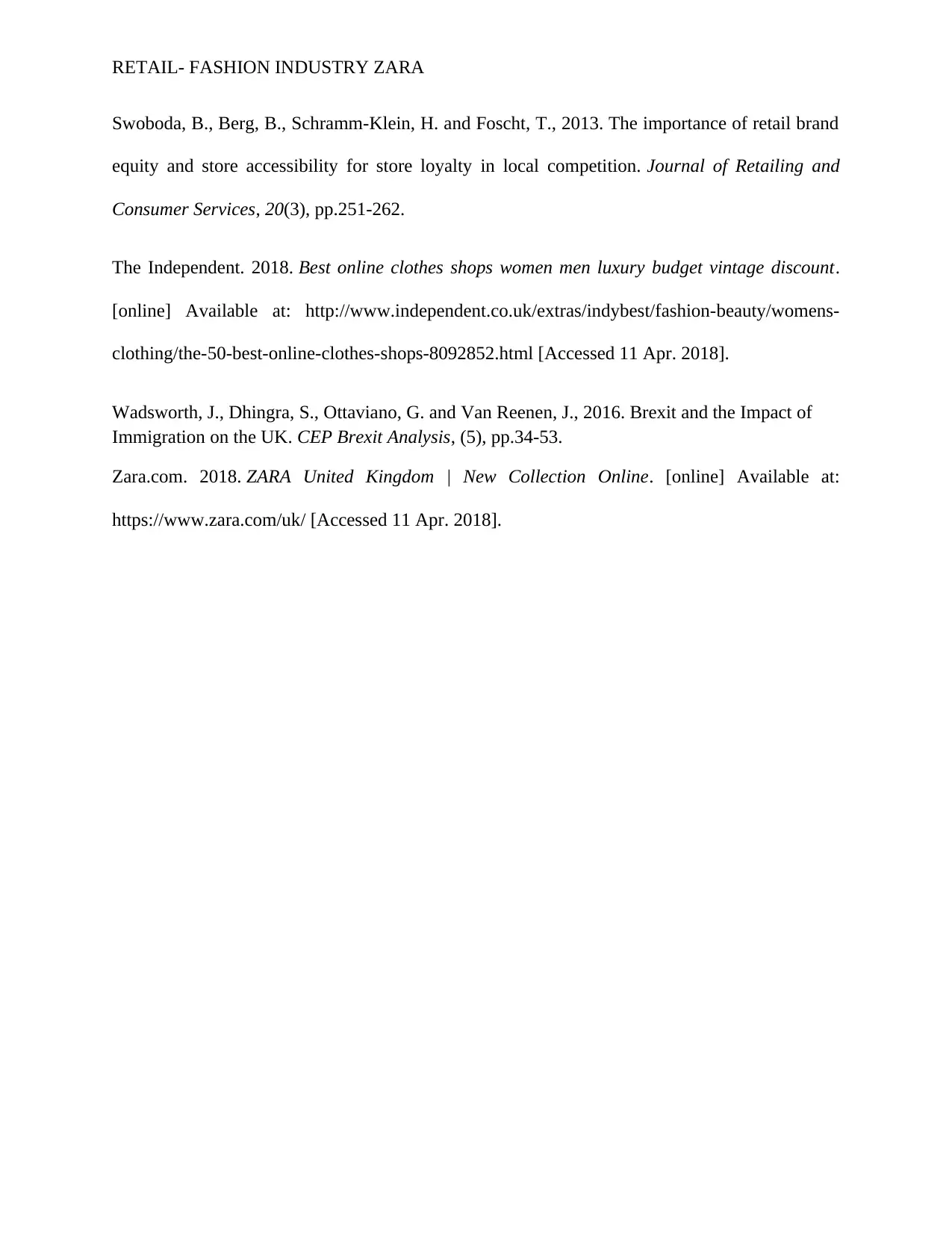
RETAIL- FASHION INDUSTRY ZARA
Swoboda, B., Berg, B., Schramm-Klein, H. and Foscht, T., 2013. The importance of retail brand
equity and store accessibility for store loyalty in local competition. Journal of Retailing and
Consumer Services, 20(3), pp.251-262.
The Independent. 2018. Best online clothes shops women men luxury budget vintage discount.
[online] Available at: http://www.independent.co.uk/extras/indybest/fashion-beauty/womens-
clothing/the-50-best-online-clothes-shops-8092852.html [Accessed 11 Apr. 2018].
Wadsworth, J., Dhingra, S., Ottaviano, G. and Van Reenen, J., 2016. Brexit and the Impact of
Immigration on the UK. CEP Brexit Analysis, (5), pp.34-53.
Zara.com. 2018. ZARA United Kingdom | New Collection Online. [online] Available at:
https://www.zara.com/uk/ [Accessed 11 Apr. 2018].
Swoboda, B., Berg, B., Schramm-Klein, H. and Foscht, T., 2013. The importance of retail brand
equity and store accessibility for store loyalty in local competition. Journal of Retailing and
Consumer Services, 20(3), pp.251-262.
The Independent. 2018. Best online clothes shops women men luxury budget vintage discount.
[online] Available at: http://www.independent.co.uk/extras/indybest/fashion-beauty/womens-
clothing/the-50-best-online-clothes-shops-8092852.html [Accessed 11 Apr. 2018].
Wadsworth, J., Dhingra, S., Ottaviano, G. and Van Reenen, J., 2016. Brexit and the Impact of
Immigration on the UK. CEP Brexit Analysis, (5), pp.34-53.
Zara.com. 2018. ZARA United Kingdom | New Collection Online. [online] Available at:
https://www.zara.com/uk/ [Accessed 11 Apr. 2018].
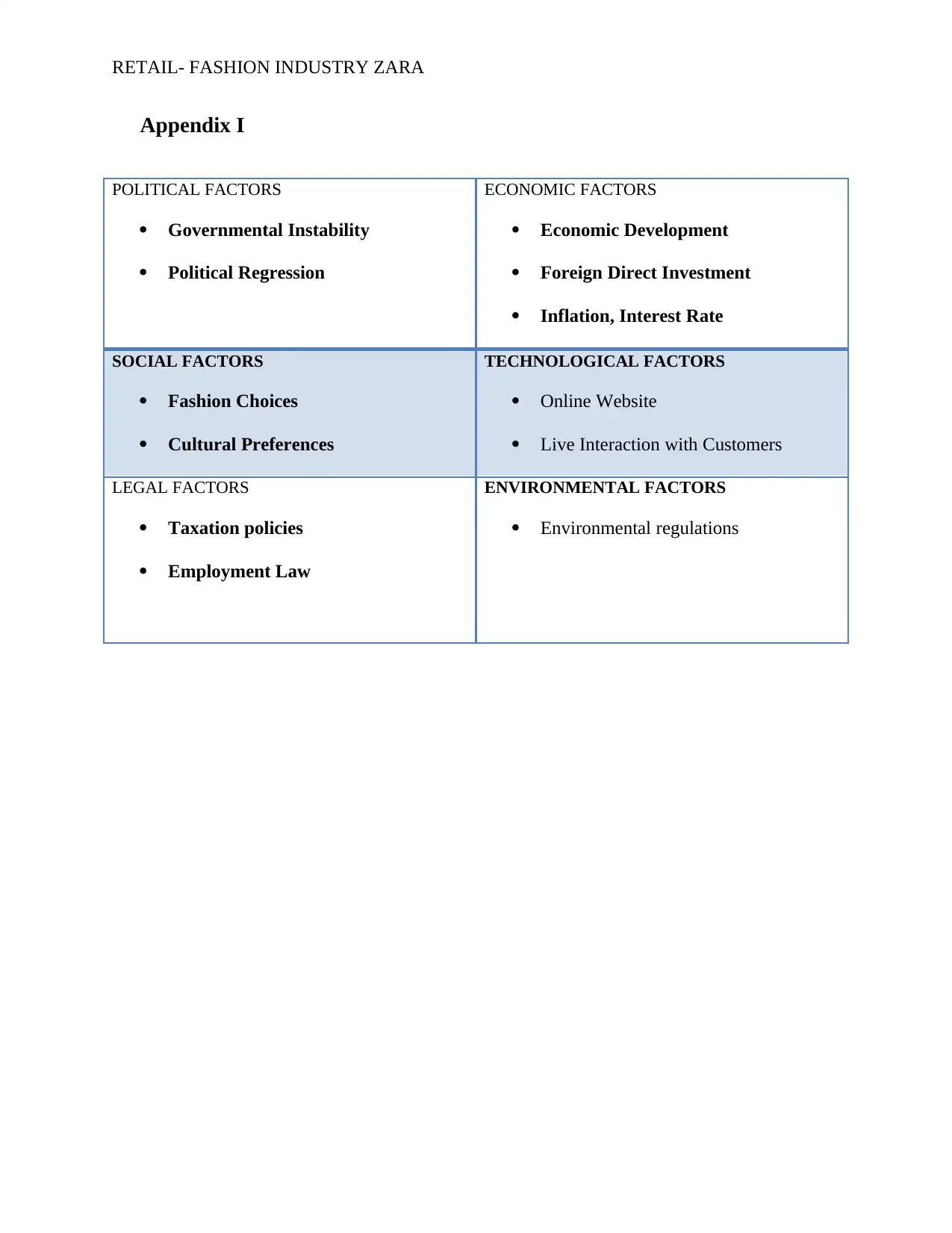
RETAIL- FASHION INDUSTRY ZARA
Appendix I
POLITICAL FACTORS
Governmental Instability
Political Regression
ECONOMIC FACTORS
Economic Development
Foreign Direct Investment
Inflation, Interest Rate
SOCIAL FACTORS
Fashion Choices
Cultural Preferences
TECHNOLOGICAL FACTORS
Online Website
Live Interaction with Customers
LEGAL FACTORS
Taxation policies
Employment Law
ENVIRONMENTAL FACTORS
Environmental regulations
Appendix I
POLITICAL FACTORS
Governmental Instability
Political Regression
ECONOMIC FACTORS
Economic Development
Foreign Direct Investment
Inflation, Interest Rate
SOCIAL FACTORS
Fashion Choices
Cultural Preferences
TECHNOLOGICAL FACTORS
Online Website
Live Interaction with Customers
LEGAL FACTORS
Taxation policies
Employment Law
ENVIRONMENTAL FACTORS
Environmental regulations
1 out of 15
Related Documents
Your All-in-One AI-Powered Toolkit for Academic Success.
+13062052269
info@desklib.com
Available 24*7 on WhatsApp / Email
![[object Object]](/_next/static/media/star-bottom.7253800d.svg)
Unlock your academic potential
© 2024 | Zucol Services PVT LTD | All rights reserved.





